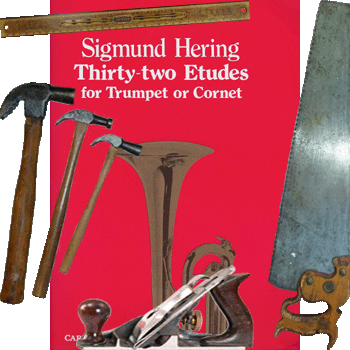|
Below is information on Sigmund Herring's Thirty-Two Etudes. In addition to some basic notes on performance, each entry includes a rendition of the etude as performed by Drew Fennell. Students may use these demonstrations as a model for preparation of lesson material. More content will be added over time.
Etude #28
Demonstration
The tempo should be brisk: dotted quarter note = 69 or eighth note = 207. When rehearsing with a metronome, the player should set the tempo at the eighth note, and when the tempo is fast enough to count accurately at the dotted-quarter, he should still carefully subdivide those eighth notes. The intervals in this study are the greatest challenge, both the octave (and larger) jumps throughout and the very angular passages which appear about 2/3rds of the way through. The student should focus on weighting the bottom notes of the leaps greater than the top notes. Despite the fact that the top notes are sometimes accented, this will achieve a much more pleasing result. Finally, any time dotted-eighth sixteenth rhythms are involved, the player should be careful. This rhythm, in whatever form it takes, is one of the most often incorrectly played in all of music. The problem is that the sixteenth note tends to be played too early. Make sure to precisely subdivide as shown in the example below.
- Allegretto [It.]: Slightly slower than allegro; medium fast.
- Poco a poco [It.]: Little by little.
- Crescendo [It.]: Growing, increasing volume.
Etude #29
Demonstration
While the metronome marking of this etude is quarter note = 84, the tempo will ultimately be dictated by the technical demands on the player - in particular the tongued triplet sixteenth notes on the second page. Though most will have to triple-tongue these passages, it may be possible for some to manage them with a single-tongue. The piece, though including many arpeggiated figures, should be played as elegantly as possible.
- Moderato [It.]: Moderate tempo.
- Poco a poco [It.]: Little by little.
- Crescendo [It.]: Growing, increasing volume.
return to Workshop Home
top of page
Copyright © 2003, 2004, 2005, 2006, 2007, 2008, 2009, 2010 Drew Fennell
International Copyright Secured All Rights Reserved
|

